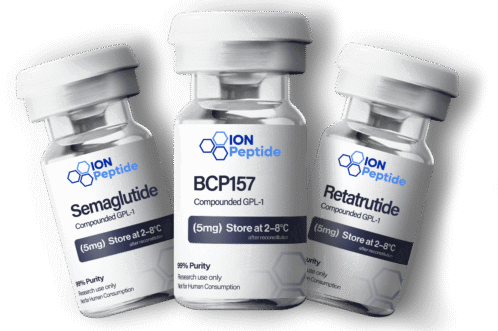Intro to Peptides
By Peptide Information
At IonPeptide.com, we believe that knowledge is power — especially when it comes to science. Our peptides are offered exclusively for in-vitro research purposes, giving scientists reliable tools to explore breakthroughs in medicine, biology, and biotechnology.
Important Notice: Our peptides are not approved for human or animal use, nor are they intended to diagnose, treat, or cure any disease. They are strictly for laboratory research and educational applications.
What is a Peptide?

A peptide is a naturally occurring chain of amino acids — the fundamental building blocks of proteins — linked together by strong chemical bonds. Think of them as tiny molecular messengers that play a crucial role in countless biological processes.
Peptides are formed when two or more amino acids connect through a bond called a peptide bond. This happens in a natural process where water is released, resulting in a stable chain that can influence everything from cell communication to hormone regulation.
The word “peptide” comes from the Greek word meaning “to digest,” which reflects how central they are to life and health. Thousands of peptides are already at work in the human body, supporting growth, healing, and normal function.
Thanks to modern science, researchers can now create peptides in the lab to study their effects and develop new applications. These discoveries hold exciting promise for the future of medicine, nutrition, and pharmaceutical innovation.
How Are Peptides Formed?
Peptides are created both naturally in the body and synthetically in the lab.
Inside the body, peptides are produced through normal biological processes — including the creation of ribosomal and non-ribosomal peptides that regulate essential functions like hormones and signaling pathways.
In the lab, scientists use advanced peptide synthesis techniques to design and create custom peptides for research. Two common approaches are:
Liquid-Phase Peptide Synthesis – ideal for certain specialized applications.
Solid-Phase Peptide Synthesis – the gold standard in research and commercial production due to its precision and efficiency.
Thanks to these innovations, researchers can now create virtually unlimited peptide sequences to explore new discoveries in medicine, nutrition, and biotechnology.
Fun Fact: The very first synthetic peptide was created in 1901 by Emil Fischer and Ernest Fourneau. Later, in 1953, Vincent du Vigneaud synthesized oxytocin — the first-ever polypeptide hormone.
Peptide Terminology
Peptides are grouped based on the number of amino acids they contain:
Dipeptide: Just 2 amino acids
Tripeptide: 3 amino acids
Oligopeptide: Short chains (usually fewer than 10 amino acids)
Polypeptide: Longer chains (10+ amino acids)
Proteins: Very long chains — typically more than 40–50 amino acids
In short, peptides are simply shorter chains of amino acids, while proteins are the longer, more complex versions.
There are exceptions, though — some very long peptides are still considered peptides, while some small proteins (like insulin) are commonly referred to as peptides.
Classification of Peptides
Peptides can be grouped into several main categories based on how they are created and where they are found.
Ribosomal Peptides:
These are made naturally by the body when cells translate genetic instructions. They often act as hormones, messengers, or regulators of important processes. Examples include tachykinin peptides, opioid peptides, pancreatic peptides, and calcitonin peptides. Some bacteria even produce ribosomal peptides like microcins, which work as natural antibiotics.
Nonribosomal Peptides:
These peptides are created by specialized enzymes rather than through ribosomal translation. They are often more complex and may form ring-like structures. Nonribosomal peptides are common in plants, fungi, and single-celled organisms. Glutathione — a powerful antioxidant that protects cells from damage — is one of the best-known examples.
Milk Peptides and Peptones:
Milk peptides come from milk proteins and can be released during digestion or fermentation (such as when milk is processed with lactobacilli). Peptones, on the other hand, are peptides derived from milk or meat that are used in laboratories as nutrient sources for bacteria and fungi.
Peptide Fragments:
These are smaller pieces of larger proteins, created naturally in the body or intentionally in the lab. Researchers study peptide fragments to understand how proteins function and to develop targeted therapies.
Important Peptide Terms
Understanding a few key terms makes working with peptides much easier. Here’s a quick guide:
Amino Acids:
The building blocks of peptides and proteins. Think of them as the alphabet used to “spell” all peptides.
Cyclic Peptides:
Peptides that form a ring-like structure rather than a straight chain. This structure often makes them more stable and resistant to breakdown. Examples include melanotan-2 and PT-141 (Bremelanotide).
Peptide Sequence:
The exact order of amino acids in a peptide — like the unique “fingerprint” of that molecule.
Peptide Bond:
The strong chemical link that connects two amino acids together, created through a natural reaction where water is released.
Peptide Mapping:
A quality-control process used by scientists to confirm the exact sequence of a peptide or protein. This is done by breaking the peptide into pieces and analyzing the pattern.
Peptide Mimetics:
Lab-created molecules that imitate natural peptides, often used in research involving hormones, enzymes, and immune responses.
Peptide Fingerprint:
A unique chromatographic pattern produced when a peptide is partially broken down and analyzed, helping researchers verify its identity.
Peptide Library:
A large collection of peptides with different amino acid combinations, used for research and drug discovery to identify new therapeutic candidates.


